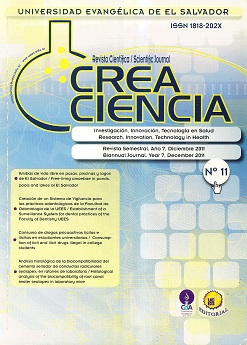Histological analysis of the biocompatibility of sealapex root canal sealant cement in laboratory mice
DOI:
https://doi.org/10.5377/creaciencia.v0i11.8146Keywords:
Sealapex, calcium hydroxide, laboratory mice, histological evaluation, calcifications, El SalvadorAbstract
The present in-vivo study was performed by histological analysis; to evaluate the biocompatibility of Sealapex Endodontic Sealant Cement, upon contact with connective tissue in laboratory mice.
This connective tissue has a great similarity with the periodontal tissues of the teeth, that is why mice were selected and thus have a better information on how calcium hydroxide (Sealapex cement) acts within the dental tissues when performing a root canal treatment.
The sample investigated was of 5 isogenic mice of the same sex; which, through a surgical intervention, were implanted subcutaneously in the connective tissue, a 1 cm long polyethylene tube containing the Cement to be investigated.
The sample was held in captivity and sacrificed in controls of 3, 7, 14,21 and 28 days. The findings were classified according to according to the degree of inflammation, fibrosis and mineralization, which presented the connective tissue against Sealapex endodontic sealant cement and demonstrated that the degree of compatibility of Sealapex sealant cement was acceptable in all cases evaluated.
The moderate fibrosis adhered to the tube containing the cement, is indicative of a good tolerance of the subcutaneous connective tissue of mice towards the product.
Similarly, it has the property of inducing the formation of mineralizations, which were detected on the connective tissue of laboratory mice.
(Promoting its alkaline pH that allows release of hydroxyl ions (OH-), unlike the acidic pH that would increase its inflammation and the lack of compatibility of sealant cement with periodontal tissues).
Therefore, it is recommended for cases of endodontically treated parts with pulp necrosis or vital pulps.
Downloads
526
Downloads
Published
How to Cite
Issue
Section
License
© Crea Ciencia
Declaration of originality and assignment of rights
The article must be sent with a declaration of originality, responsibility and assignment of rights of copy of the manuscript, scanned and signed by the author or by one of the authors when the authorship is collective (designated author), stating that the text has not previously published in printed or electronic format, which will not be presented to any other media before knowing the decision of the journal Crea Ciencia and that, if accepted for publication, the authors transfer the copyrights in all forms and media known. At the end of six months of the publication, the text can be shared in another magazine citing the first version of the article published in Crea Ciencia and recording its number and volume. If the article is not published, the UEES agrees to return the rights enunciated to their authors.

Crea Ciencia articles are published in open access and licensed under a Creative Commons Attribution-NonCommercial 4.0 International License.

